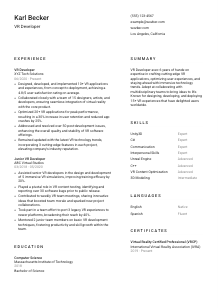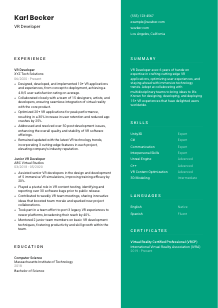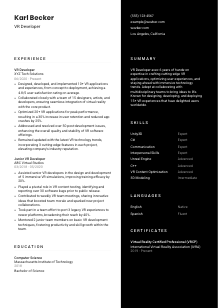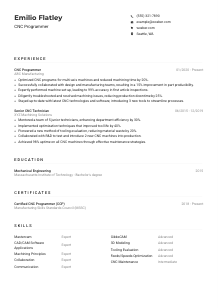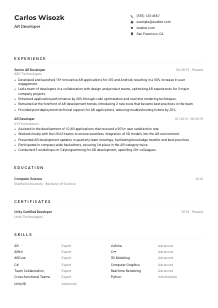VR Developer CV Example
Creating virtual realms, but your CV feels stuck in reality? Venture into this VR Developer CV example, crafted with Wozber free CV builder. See how seamlessly you can synchronize your virtual vision with job expectations, virtually turbocharging your career path in immersive wonderlands!

How to write a VR Developer CV?
Venture into the realm of Virtual Reality (VR) development, where your CV becomes a portal into your professional prowess. You're not just seeking a job; you're enrolling in an extraordinary mission to shape immersive experiences. With Wozber's free CV builder at your side, let's embark on a journey to design a CV that not only meets the job specifications but also passes the vigilant eyes of the Applicant Tracking Systems (ATS). This guide aims to transform your CV into a beacon for hiring managers, tailoring it precisely to the VR Developer position you covet.
Personal Details
Your introduction is your first virtual handshake. Make it count by imbuing your Personal Details section with a level of precision that mirrors the meticulous nature of VR development. Let's delve into perfecting this section, ensuring that it aligns seamlessly with the nuances of the VR Developer role, making it ATS-compliant right from the start.
1. The Name Game
Your name is the beacon that guides recruiters through your professional landscape. Ensure it's prominently placed, reflecting the clarity and professionalism inherent to a VR Developer. A larger, readable font here sets the stage.
2. Aligning Titles
Positioning yourself as a VR Developer immediately below your name aligns your professional identity with the job at hand. It's a strategic move that harmonizes your aspirations with the role, guiding the ATS and recruiter alike.
3. Contact with Precision
Your phone number and a professional email (think firstname.lastname@gmail.com) are your digital coordinates, ensuring the recruiter can navigate directly to you without any detours. Remember, clarity and accessibility here are key.
4. Location Sync
Stating "Los Angeles, California" not only meets the geographical requirement but reassures the hiring manager of your ready availability, eliminating any potential relocation barriers, crucial for quickly filling the role.
5. Digital Presence
In a profession as forward-thinking as VR Development, showcasing your online portfolio or LinkedIn profile can give you a competitive edge. Ensure it's up-to-date, and reflects the creativity and skill evident in your CV.
Takeaway
Crafting the Personal Details section with an eye for detail sets the tone for your ATS-compliant CV. It's your first opportunity to align with the job's requirements while ensuring your contact information is unmissable. Take your time here; it's the prelude to your professional narrative.





Experience
The Experience section is the battleground where you showcase your victories. It's where your journey as a VR Developer takes form, with each role contributing to the narrative of a professional poised to innovate and excel in VR development.
- Designed, developed, and implemented 10+ VR applications and experiences, from concept to deployment, achieving a 4.8/5 user satisfaction rating on average.
- Collaborated closely with a team of 15 designers, artists, and developers, ensuring seamless integration of virtual reality with the core product.
- Optimised 20+ VR applications for peak performance, resulting in a 30% increase in user retention and reduced app crashes by 25%.
- Addressed and resolved over 50 post‑development issues, enhancing the overall quality and stability of VR software offerings.
- Remained updated with the latest VR technology trends, incorporating 3 cutting‑edge features in each project, elevating company's industry reputation.
- Assisted senior VR developers in the design and development of 5 immersive VR simulations, improving training efficacy by 20%.
- Played a pivotal role in VR content testing, identifying and reporting over 30 software bugs prior to public release.
- Contributed to weekly VR team meetings, sharing innovative ideas that boosted team morale and sparked new project collaborations.
- Took part in a team effort to port 3 legacy VR experiences to newer platforms, broadening their reach by 40%.
- Mentored 2 junior team members on basic VR development techniques, fostering productivity and skill growth within the team.
1. Decipher the Code
Begin by dissecting the job description. Highlighting phrases like "designed, developed, and implemented VR applications" or "collaborated closely with designers, artists, and developers" gives you a blueprint to mirror in your CV.
2. Chronology of Success
Depict your professional journey in reverse chronological order, laying out your roles, tenures, and the companies that were pivotal in your development. This linear narrative makes your growth and accomplishments easily digestible for both the ATS and human readers.
3. Achievement Unlocked
Tailor your bullet points to echo the triumphs and tasks in the job description. Use action verbs and quantify outcomes where possible, turning a generic list into a compelling story of achievements, like increasing user retention or enhancing app performance.
4. Numbers Speak Louder
Quantify your success stories - whether it's improving app performance by 30% or collaborating with a team of 15. Numbers draw the eye and provide objective metrics of your contributions and impact.
5. Relevance is Key
Your journey in table tennis might be remarkable, but keep your focus sharp - every bullet point should resonate with the responsibilities and requirements of a VR Developer. This isn't just your history, it's your argument for why you're the perfect fit.
Takeaway
Your Experience section is a testament to your journey and capabilities. It's a curated gallery of your professional achievements, tailored to showcase your fit for the VR Developer role. Ensure it speaks the language of impact, innovation, and relevance.
Education
The Education section is more than a list of degrees; it's the bedrock of your expertise, especially in a field as specialized as VR Development. Let's tailor this section to reflect not just your educational achievements, but also your readiness for the role.
1. Degree Precision
Identify the exact requirement from the job description - a "Bachelor's degree in Computer Science, Game Design, or a related field." Your listing should mirror this, ensuring there's no discrepancy between your qualifications and their criteria.
2. Structure for Clarity
Maintain simplicity and clarity in this section. The order - your field of study, the degree obtained, the institution, and your graduation date - forms a straightforward narrative that's easy for the ATS to parse and for recruiters to absorb.
3. Degree Alignment
If the role precisely specifies a Bachelor's in Computer Science, and you have that degree, make it prominent. This direct alignment with the job criteria speaks volumes of your preparation for the VR Developer role.
4. Coursework and Projects
For roles deeply embedded in technology and innovation, highlighting relevant coursework or projects can be a plus, especially if you're in the early stages of your career. If you've worked on anything VR-specific, this is the place to showcase it.
5. Achievements and Associations
Additional educational milestones, like honors or relevant extracurriculars, can differentiate you. While they may hold less weight for senior roles, they can be compelling for those at the outset of their careers.
Takeaway
Your Education section is a snapshot of your academic journey, tailored to highlight your preparedness for the VR Developer role. Keep it focused, relevant, and in direct conversation with the job's requirements.
Certificates
Certificates are the cherry on top of your professional sundae; they showcase your dedication to continuous learning and specialization. In the ever-evolving field of VR, staying updated is crucial. Let's curate this section to illuminate your most relevant achievements.
1. Fit the Mold
Start by evaluating the job description for any direct mentions of required certifications. For roles that don't specify, consider the technologies and skills that are emphasized, and select certificates that reflect your proficiency in those areas.
2. Quality Over Quantity
Listing every certificate you've ever obtained can be overwhelming and dilute the impact of the most relevant ones. Choose to showcase certifications that directly contribute to your suitability as a VR Developer.
3. Dates Matter
For certifications, especially in fast-paced fields like VR, indicating the date of acquisition can highlight your up-to-date knowledge and continuous learning mindset. This can be particularly persuasive for positions at the cutting edge of technology.
4. Continuous Learning
The VR landscape is always shifting, with new technologies and methodologies emerging. Display your commitment to keeping at the forefront of these changes by actively pursuing new certifications and learning opportunities.
Takeaway
Once a supplementary section, Certificates have evolved into a powerhouse showcasing your dedication and expertise. Choose wisely and update regularly, ensuring they enrich your narrative as a VR Developer poised for innovation.
Skills
The Skills section of your CV is where your technical prowess meets your soft skills, painting a comprehensive picture of you as a VR Developer. Here, clarity and strategy will ensure this section complements the job description precisely, making your CV ATS-optimised.
1. Tailor to Tech
Dive deep into the job description, extracting skills like proficiency in Unity3D, Unreal Engine, C++, and C#, and mirror these in your CV. Remember, the ATS is scanning for these specific skills, so aligning them with the job description is critical.
2. The Full Picture
While the technical skills are non-negotiable, don't overlook soft skills like "excellent communication and interpersonal skills." These complement your technical acumen, indicating your capability to thrive in collaborative, multidisciplinary teams.
3. Less Is More
Resist the temptation to list every skill you possess. Instead, focus on the essential skills that the job description highlights. This strategic selection ensures your CV is succinct and targeted, making it more likely to catch a recruiter's eye.
Takeaway
Your Skills section is a potent mix of your technical capabilities and soft skills, presented in harmony with the job's requirements. Fine-tune this section to reflect the core competencies of a VR Developer, ensuring an ATS-optimised, recruiter-friendly presentation.
Languages
In a profession that often transcends borders, your linguistic abilities can serve as a vital asset, broadening your professional appeal and potential for collaboration. Tailoring the Languages section to the job's global context enriches your profile as a versatile VR Developer.
1. Primary Requirement
"High level of fluency in English required." This non-negotiable skill should take precedence, clearly stated at the top of this section. It's not just a requirement; it's your ticket to seamlessly integrate into diverse teams.
2. Additional Lingual Skills
While English remains paramount, other languages you're fluent in can showcase your versatility and potential for global projects. Each additional language is a plus, making you a more attractive candidate for roles that value global communication.
3. Honesty in Proficiency
Accuracy in depicting your linguistic capabilities is key. Whether you're "native," "fluent," or "intermediate," clear labels prevent misunderstandings and set realistic expectations for your role in multi-lingual environments.
4. International Appeal
For roles with a global reach or clientele, your multilingual skills can become a significant advantage, offering a direct line to clients and collaborators worldwide. It's a unique selling point, underscoring your global perspective.
5. Continuous Improvement
Language skills, like technological ones, require upkeep and improvement. In an interconnected world, your ability to communicate across cultures is invaluable, continually enhancing your professional toolkit.
Takeaway
Your linguistic abilities are more than a section on your CV; they're a clear statement of your capability to engage and excel in a global market. Highlight them with pride, showcasing your readiness for diverse, international collaborations.
Summary
Your Summary is the gateway to your professional world, encapsulating your journey, skills, and aspirations in a few, carefully chosen words. Crafting this section with an eye towards the VR Developer role you're targeting ensures your CV immediately captures attention.
1. The Core of the Matter
Start with a clear understanding of the job description, letting its key requirements guide the elements you highlight in your summary. Your experience, skills, and the impact you've made should resonate with what they're seeking.
2. Opening Statement
Introduce yourself in a manner that captures both your professional identity and your passion for VR Development. This sets the stage, inviting the recruiter to delve deeper into the narrative of your CV.
3. Connect the Dots
Weave in skills and accomplishments that speak directly to the job's requirements, such as your proficiency in Unity3D or Unreal Engine, or your track record of designing immersive VR experiences. This connects your story to their needs.
4. Brevity and Impact
Keep your summary concise yet impactful, distilling your essence into a few potent sentences. Think of it as your professional pitch, grabbing attention and compelling the reader to explore further.
Takeaway
Your Summary isn't just an introduction; it's an opportunity to make a lasting impression, positioning you as the ideal candidate for the VR Developer role. Craft it with care, ensuring it mirrors the essence of the job description and showcases your unique brand.
Launching Your VR Developer Journey
Congratulations on navigating through this guide to crafting a tailored, ATS-compliant CV for the VR Developer role. With insights from Wozber's free CV builder, including ATS-friendly CV templates and the ATS CV scanner, you're equipped to present a compelling narrative that aligns perfectly with your career ambitions. The path to your next exciting role in VR development is now laid out before you. Remember, your CV is the key to unlocking new dimensions of professional opportunity.
Refine it, personalize it, and let it serve as your portal into the dynamic world of VR. Embrace the journey ahead, and may your career in VR development be as immersive and groundbreaking as the experiences you create.

- Bachelor's degree in Computer Science, Game Design, or a related field.
- Minimum of 3 years of professional experience with virtual reality (VR) development.
- Proficient in Unity3D and/or Unreal Engine.
- Strong background in C++ and/or C# programming languages.
- Excellent communication and interpersonal skills for collaborating with multidisciplinary teams.
- High level of fluency in English required.
- Must be located in Los Angeles, California.
- Design, develop, and implement VR applications and experiences from concept to deployment.
- Collaborate with designers, artists, and other developers to ensure the best user experience and maximize the potential of the VR medium.
- Optimize VR applications for performance, user interaction, and hardware compatibility.
- Stay updated with the latest trends and advancements in VR technology to continuously enhance products.
- Debug, test, and provide documentation for VR applications and address any post-development issues.





